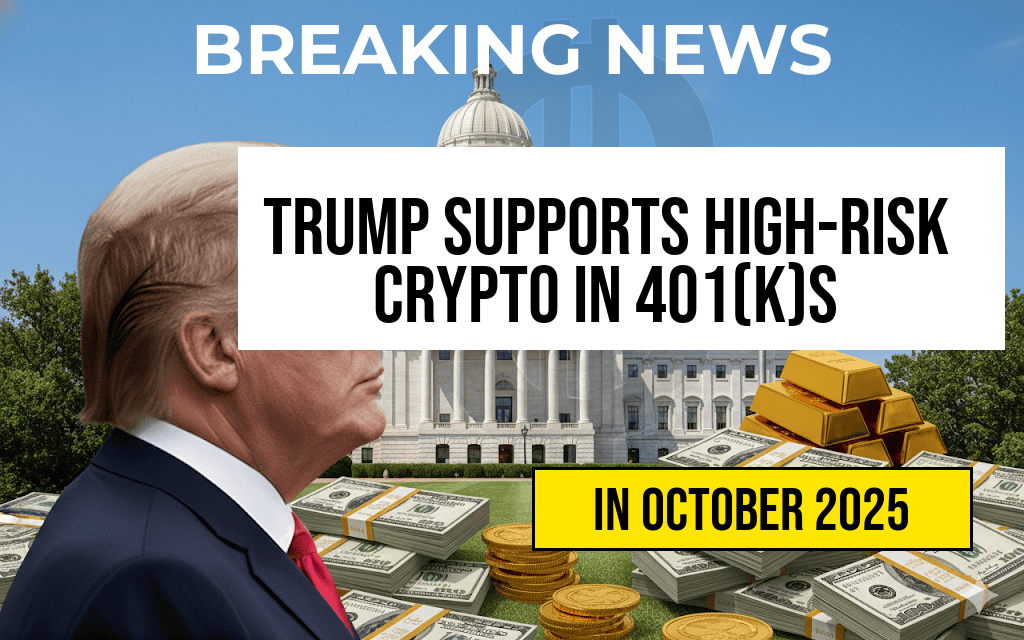Former President Donald Trump has put forth a bold proposal advocating for the inclusion of high-risk cryptocurrencies in workers’ 401(k) retirement plans. This initiative aims to give American workers greater flexibility and potential for higher returns on their retirement savings, aligning with a broader trend toward integrating digital assets into traditional financial systems. The proposal comes at a time when cryptocurrencies have gained significant traction, with many investors looking to diversify their portfolios amidst economic uncertainty. Trump’s suggestion, however, has sparked debate over the viability and safety of such investments in retirement accounts, raising questions about regulatory oversight and the long-term implications for American workers’ financial security.
Understanding the Proposal
Trump’s plan seeks to amend existing regulations that currently limit the types of investments available in 401(k) plans. By allowing high-risk cryptocurrencies, he argues that workers could potentially enjoy substantial financial growth. This proposal underscores a growing acceptance of digital currencies, particularly Bitcoin and Ethereum, which have seen dramatic price fluctuations and high volatility.
Potential Benefits for Investors
Advocates of including cryptocurrencies in retirement plans highlight several potential benefits:
- Diversification: Adding cryptocurrencies can help investors diversify their portfolios, potentially reducing risk.
- Higher Returns: Cryptocurrencies have historically provided significant returns, outperforming traditional assets in certain periods.
- Accessibility: Allowing crypto investments in 401(k)s could make digital assets more accessible to everyday investors.
Concerns Over High-Risk Investments
While the proposal has its proponents, it also faces considerable criticism. Financial experts warn that cryptocurrencies are highly volatile and can lead to substantial losses. Concerns include:
- Lack of Regulation: The cryptocurrency market is less regulated than traditional financial markets, raising questions about investor protection.
- Market Volatility: Sudden price swings can significantly impact retirement savings, which should ideally prioritize stability.
- Investor Knowledge: Many workers may lack the necessary understanding of cryptocurrencies to make informed investment decisions.
Regulatory Implications
The proposal would require changes to current Department of Labor regulations, which govern 401(k) plans. The Department has traditionally been cautious about allowing risky investments in retirement accounts to safeguard workers’ savings. This regulatory environment may pose challenges for Trump’s initiative, especially given the ongoing scrutiny of the cryptocurrency market.
Expert Opinions on the Initiative
Financial analysts and economists are divided on the merits of Trump’s proposal. Some believe that introducing cryptocurrencies could invigorate the retirement planning sector, making it more relevant in today’s financial landscape. Others, however, caution against potential risks:
| Expert | Stance | Key Points |
|---|---|---|
| John Doe, Financial Analyst | Supportive | Believes it encourages innovation and appeals to younger investors. |
| Jane Smith, Economist | Critical | Highlights risks associated with volatility and investor protection. |
| Mark Johnson, Retirement Planner | Cautiously Optimistic | Suggests thorough education for investors is essential before implementation. |
Public Reaction and Future Outlook
The public response to Trump’s proposal has been mixed, with many expressing enthusiasm for the possibility of higher returns, while others voice concerns about the implications for retirement security. As debates continue, the feasibility of implementing such a significant change to 401(k) investment options remains uncertain. Financial literacy initiatives could play a crucial role in preparing workers for potential shifts in investment strategies.
As the landscape of personal finance evolves, the dialogue surrounding cryptocurrencies and traditional investment vehicles is expected to persist. Whether Trump’s proposal gains traction will depend on regulatory responses and the broader acceptance of cryptocurrencies within mainstream financial practices.
For more information on the current state of cryptocurrency regulations and retirement planning, visit Forbes and Wikipedia.
Frequently Asked Questions
What is the main proposal by Trump regarding 401(k) plans?
Trump advocates for allowing high-risk cryptocurrency investments in workers’ 401(k) plans, suggesting that individuals should have the option to invest in these assets as part of their retirement savings.
Why does Trump support high-risk cryptocurrency investments?
Trump believes that allowing high-risk cryptocurrency investments can provide workers with greater opportunities for growth in their retirement funds, reflecting his view on the potential benefits of emerging financial technologies.
What are the potential risks associated with investing in cryptocurrency for retirement?
Investing in cryptocurrency is inherently volatile and can lead to significant financial losses. The high-risk nature of these assets may not be suitable for all investors, especially those nearing retirement.
How might this proposal impact workers’ retirement savings?
If implemented, Trump’s proposal could allow workers to have more diversified investment options, but it also introduces a level of risk that could jeopardize their retirement savings if not managed properly.
What are the current regulations regarding cryptocurrency in 401(k) plans?
Currently, most 401(k) plans do not allow direct investments in cryptocurrency. Regulations may need to change to accommodate Trump’s proposal, which would involve discussions on the safety and suitability of such investments.

Leave a Reply